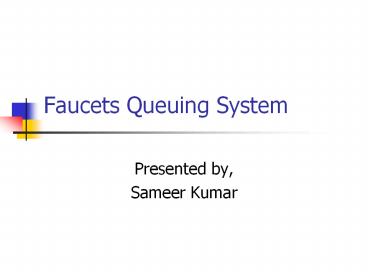Faucets Queuing System - PowerPoint PPT Presentation
Title:
Faucets Queuing System
Description:
Faucets Queuing System Presented by, Sameer Kumar Basic Idea Queuing System to manage Adaptive Jobs Adaptive jobs Jobs that can shrink and expand at runtime ... – PowerPoint PPT presentation
Number of Views:84
Avg rating:3.0/5.0
Title: Faucets Queuing System
1
Faucets Queuing System
- Presented by,
- Sameer Kumar
2
Basic Idea
- Queuing System to manage Adaptive Jobs
- Adaptive jobs
- Jobs that can shrink and expand at runtime
- Simulations Provided encouraging results
- Also intended to be a general purpose queuing
system that supports Generic, non-migratable
Charm and MPI jobs
3
Adaptive Jobs
- Jobs that can dynamically increase (expand) or
decrease (shrink) the number of processors they
are running on - Motivation
- Improve system utilization
- Decrease system response time
- Properties
- minpe, minimum number of processors required for
the job, related to the memory requirements of
the job - maxpe, maximum number of processors, related to
speedup - profit, profit from running the job
- deadline, deadline before which the job should be
finished
4
Adaptive Job Example
- Consider a 128 processor system
- Job A arrives and requests 80 Processors and is
started on 80 processors - Job B then arrives and requests 64 processors
- In traditional systems Job B will be queued and
allocated 64 processors only after Job A
finishes, while part of the system remains idle - With adaptive jobs Job A can be shrunk to 64
processors and Job B can be started and after job
A finishes Job B can expand and use all the
processors
5
Adaptive Job Scheduler
- Adaptive Job Scheduler manages adaptive jobs
- Three major components
- Job Manager
- Accepts jobs, schedules them on the parallel
system, and frees resources when the job is done - Scheduling Strategy
- A plug-able component that makes decisions on
which jobs to schedule - Database
- Logs all events that occur in the scheduler and
can be used in case of a crash
6
Adaptive Job Scheduler
7
Performance
- Simulation Results on 64 processors with mean job
execution time of 64.5 sec for utilization
maximizing - strategy
- Experiments on Linux Cluster on 64 processors and
mean job execution time of 60 sec
?Arrival Rate MRT Mean Response
Time Utilization Processor utilization Load
Factor (lf) Execution Time?
8
Features
- Multithreaded for fast response
- Logs all job related information to a database
- This helps in crash recovery and,
- Improves security of the system
- Uses Unix sockets for communication
- Unix Sockets improve the efficiency of the system
- The also restrict access to the scheduler
- Provides timed termination of the jobs
9
Features (continued)
- Accepts both batch and interactive jobs
- MaxPE and MaxTime are parameters to the system
and can be used to restrict unlimited access to
the parallel machine - Tested on the cool Linux cluster at PPL
- Adaptive jobs currently implemented in Charm
and MPI - For more details check out
- http//charm.cs.uiuc.edu/research/faucets/faucets.
html
10
Super-user Access
- The Queuing system scheduler runs with super-user
privileges - When a new job arrives it is executed with the
permissions of the user - The code has been checked for stack overflows
- Direct Access to the parallel machine is blocked
by removing the permissions for rsh, ssh etc - To start a job the scheduler changes its group id
to a Queuing System group which can access the
cluster
11
Queuing System Commands
- Similar to current queuing systems
- fsub is the command to submit batch jobs to the
queuing system - frun runs jobs interactively
- fjobs lists the jobs
- fkill can be used to kill jobs
12
Conclusions and Future Work
- Queuing system has been tested and is ready to be
installed on the Turing cluster - Make the scheduler manage multiple heterogeneous
clusters by supporting the concept of queues - Some of the queues could be batch and others
interactive - Interactive queues would allocate multiple jobs
to the same node depending on the utilization of
the nodes - Running the scheduler on SP2 and other
multiprocessing architectures - One of the solutions would be to run the faucets
scheduler on top of a commercial queuing system































